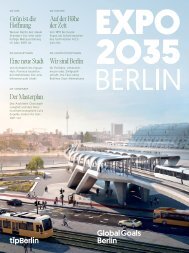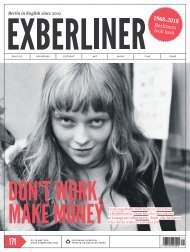Exberliner issue 185, September 2019
- No tags were found...
Create successful ePaper yourself
Turn your PDF publications into a flip-book with our unique Google optimized e-Paper software.
COLUMN— Save Berlin<br />
Beige, grey<br />
or cosplay?<br />
From the Humboldt Forum<br />
to Potsdam’s Barberini – what<br />
should we make of the historicist<br />
revival in architecture?<br />
Last year, Zum Umsteiger shut its doors<br />
after 113 years. The legendary tavern<br />
across from Yorckstraße station (photo<br />
top) had survived the Nazis, World War II and<br />
the Cold War, but a worse horror was still to<br />
come: its new neighbours. The quaint building<br />
is wedged between an oppressive apartment<br />
complex and an intrusive parking garage entry.<br />
Lonely Zum Umsteiger is an unwanted relic<br />
screaming out for a bunch of coloured balloons<br />
to carry it away.<br />
With its high-pitched roof and faux-gothic<br />
brickwork, Umsteiger is a throwback to an<br />
architectural style known as historicism. For<br />
thousands of years, designing a building meant<br />
finding an existing model to copy – every bank<br />
was a Roman temple, every apartment block a<br />
Florentine palazzo. Historicism was a crutch<br />
that helped even mediocre architects create<br />
great buildings. However, since modernism<br />
arrived a century ago and lifted the yoke of historical<br />
styles, anything goes. Genius designers<br />
produce an occasional work of brilliance, but<br />
they’re just as likely to lay an<br />
architectural egg. Despite our<br />
ongoing construction boom,<br />
try finding one recent building<br />
with one-tenth the character of<br />
sad little Umsteiger.<br />
Maybe that’s why Germans<br />
have embraced a new form of<br />
historicism – modern buildings<br />
dressed up like long-gone architectural<br />
icons. Berlin’s Humboldt<br />
Forum is a 21st-century museum<br />
wrapped in an 18th-century palace<br />
facade. Across the Spree, the<br />
2003 Bertelsmann Foundation HQ is costumed<br />
as the baroque Alte Kommandantur. In 2016,<br />
Potsdam unveiled two shiny new buildings in<br />
the guise of “baroque” palaces, one housing<br />
the offices of Brandenburg’s parliament and<br />
the other, the nearby Museum Barberini.<br />
Frankfurt am Main has recreated a whole new<br />
“historic” city centre. Opened last <strong>September</strong>,<br />
the new Altstadt is packed with tourists who<br />
love its selfie-friendly faux-olde facades. But<br />
the historicalness is only skin deep – it’s a<br />
kind of architectural cosplay.<br />
Daniel Cati<br />
Dan Borden on<br />
architecture and<br />
urban politics<br />
Playing architectural politics<br />
The narrative around Potsdam’s Garnisonkirche<br />
has a familiar ring: after WWII,<br />
its bomb-damaged remains were bulldozed,<br />
and proponents say its current reconstruction<br />
corrects that tragic mistake. However,<br />
critics decry the spread of “Disneyfication”<br />
and worry about “correcting” the past. Even<br />
scarier, the church has links to right-wing<br />
politics. The first calls to rebuild it came in<br />
the 1990s from Max Klaar, a notorious Nazi<br />
fan whose goal was to restore the place where<br />
Adolf Hitler shook hands with<br />
Field Marshal Hindenburg and<br />
thus secured his position as<br />
German chancellor. Similarly,<br />
Frankfurt’s Altstadt was the<br />
brainchild of Claus Wolfschlag,<br />
another right-wing author who<br />
links traditional buildings with<br />
“true” German identity.<br />
Did Klaar, Wolfschlag and<br />
others really hope their resurrected<br />
structures would drive<br />
Germany’s politics to the right?<br />
If so, they’re likely to be disappointed.<br />
Buildings are remarkably ineffectual<br />
devices of political coercion. For example,<br />
no building better embodies Hitler’s politics<br />
of intimidation than the Luftwaffe HQ near<br />
Potsdamer Platz (1936). Still, it was converted<br />
into East Germany’s House of Ministries with<br />
the simple addition of a mosaic depicting<br />
cheerful socialist workers. Currently serving<br />
as Germany’s Finance Ministry, the hulking<br />
building has yet to compel passers-by into<br />
making a Nazi salute or breaking into a chorus<br />
of The Internationale.<br />
Designing a sexy future<br />
In spite of its critics, the resurrection juggernaut<br />
seems unstoppable. Is it time to jump on board<br />
and seize control from the right-wing nut jobs?<br />
After all, what’s more delusional, losing ourselves<br />
in rosy nostalgia or looking forward to a “rosy”<br />
future personified by soulless beige and grey<br />
boxes? Once our Humboldt Forum is finished,<br />
workers will cross the Spree and rebuild Karl<br />
Friedrich Schinkel’s Bauakademie. Then what?<br />
My candidate for reconstruction is Richard<br />
Lucae’s 1872 Villa Joachim, which found its<br />
higher calling in 1919 as Magnus Hirschfeld’s<br />
Institute of Sexual Research (photo bottom).<br />
Hirschfeld was an openly-gay man whose work<br />
revolutionised ideas about sex and sexual<br />
identity. Though destroyed by the Nazis and<br />
WWII, the villa and Hirschfeld’s collection were<br />
thoroughly documented by photos, making an<br />
accurate reconstruction very doable. Returning<br />
it to its rightful home near today’s Haus der<br />
Kulturen der Welt would cement Berlin as the<br />
true birthplace of modern sexual freedom. T<br />
Architekturmuseum der Technischen Universität Berlin<br />
48<br />
EXBERLINER <strong>185</strong>


















